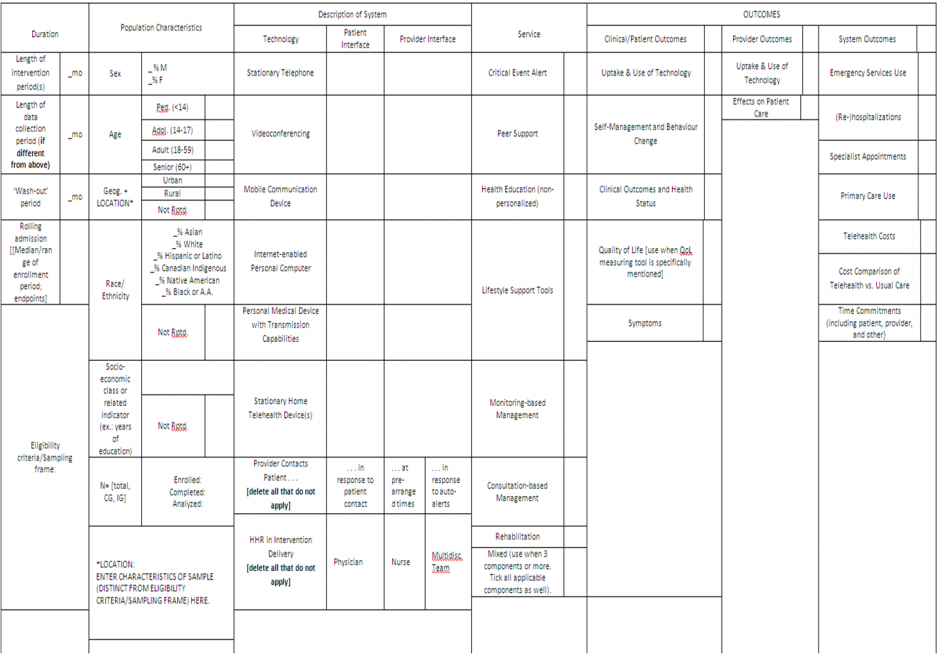(1) Code Sheet (above)
Please contact Alison Jones (alison.j@ubc.ca) for a clearer copy of the sheet above.
(2) Guidelines for Reviewers
Column 1: Duration
Include length of intervention, length of data collection period, and, if applicable, length of ‘wash-out’ period for cross-over studies. For cross-over or multi-stage studies, record the number and length of intervention periods (ex.: 2×6 months, 3×3 months).
If the study used rolling admission, enter the median length of enrollment and the range of enrollment length (if available), as well as the designated endpoint. Be succinct; avoid entering extensive descriptive information.
In the open-text field, enter the sampling frame and/or eligibility criteria. Note that this is not synonymous with sample characteristics.
Column 2: Population Characteristics
Provide the following information for both intervention groups (IG) and control groups (CG) wherever possible (baseline data preferred). If IG and CG are not reported separately, provide information for the study population as a whole. If the authors only include the demographics of the sampling frame or reference population, give that data, preceded by ‘Ref. pop.’.
Age: Classify as Pediatric (<14), Adolescent (14-18), Adult (18-59), and/or Senior (60+). If more than one age range is included in the study population, select all that apply. If only the mean average is given, tick the box that applies and note this limitation in the text field. If the authors have broken the population down into age brackets, indicate what percentage of the population falls into each bracket. In the text field, enter the exact age range(s) (including mean, median, and standard deviation, if given).
Geog. + Location: Record whether population is primarily rural, primarily urban, or mixed. Record more detailed information in notes field
Sex: % male and/or % female. Include data for both control and intervention groups when possible.
Race/Ethnicity: Provide as %. If authors use qualitative terms (ex.: ‘Mostly White’), record information as given and note lack of exact numbers in brackets. Example: % White: ‘Mostly White’ [numbers not given].
Socioeconomic Status or Related Indicator (ex. years of education): Due to the difficulty of interpreting data such as annual income, record any indicators as given.
N=: Where available, include all of the following: number enrolled, number completed, and number analyzed. Record numbers for both IG and CG. Record numbers even if the number enrolled is the same as the number completed/analyzed. If information is not available, leave blank.
In the open-text field:
1) Record the location of the study (country/state or province/city or catchment area).
2) Describe the sample characteristics, including co-morbidities and health status. Do not repeat information captured in the checkbox regions of this column.
Description of Intervention
a) (Classification) Note whether the main hardware component of the telehealth intervention would best be categorized as:
Stationary Telephone: Use of a standard telephone (landline).
Videoconferencing: Check box if videoconferencing is used, regardless of whether it takes place via webcam, camera phone, or other. If videoconferencing is used in conjunction with other tools, check all that apply.
Mobile Communication Device: Mobile phone, Smartphone, or similar device.
Personal Medical Device with Transmission Capability: Implanted, wearable, or portable device designed specifically for disease management. ‘Transmission capability’ can mean wireless transmission or the ability to interface with another transmitting device, such as an internet-enabled computer or a telephone line.
Internet-enabled Personal Computer: Self-explanatory.
Stationary Home Telehealth Device(s): These are often hub-type devices that use touchscreens for data entry and may include ‘disease dialogues’. Use also when data is being transmitted from generally stationary devices such as a scale or blood-pressure monitor.
b) (Description)
Provider Contacts Patient . . .: Select the box(es) that describe the circumstances under which the provider contacts the patient. More than one may apply.
HHR in Intervention Delivery: Record whether intervention was provided by physicians, nurses, or a multidisciplinary team. Categories are mutually exclusive; for a mixed team of physicians and nurses (and/or researchers, etc.), tick ‘Multidisciplinary team’. Focus on whether the individuals mentioned have significant involvement in the delivery of the intervention. Expand on selection in general comments area (below) when appropriate.
General: Describe telehealth system. Include hardware components, description of software used, and any directions given to patient regarding frequency of use. Note whether the intervention was a stand-alone program, or was incorporated into an existing initiative. Describe the care given to the control group if this information is provided.
Service
Classify the primary purpose of the technology used as:
Critical Event Alert: Data is communicated in real time, with the expectation is that the provider will react immediately; triggering values are not simply ‘out of range’, but are indicative of an imminent and potentially life-threatening event.
Peer Support: Self-explanatory.
Health Education (non-personalized): Patients and/or caregivers are provided with educational material. This could include webpages, disease management scripts, daily text messages, or the provision of general educational information by providers. Use this category when the information is not customized for individual needs (if information is customized, consider whether ‘Monitoring-based Management’ or ‘Consultation-based Management’ is applicable).
Lifestyle Support Tools: Exercise and diet logs, personal journals, coping strategies, etc. These are designed to help the patient with self-management. The provider may have access to them, but it is the process of using the tool that is supposed to yield the most benefit for the patient.
Monitoring-based Management: Treatment, medication, and management advice based on data transmissions or patients’ answers to pre-scripted questions.
Consultation-based Management: Treatment, medication, and management advice based on consultation sessions/teleappointments with patient.
Rehabilitation: Self-explanatory.
Mixed: Use when three or more of the above categories apply. Tick all applicable components as well. Use sparingly.
Clinical/Patient Outcomes
Uptake and Use of Technology: Any information on patient uptake and use of technology (satisfaction, perceived ease of use, etc.)
Self-Management and Behavior Change: Compliance, medication use, etc.
Clinical Outcomes and Health Status: Vital signs, laboratory tests, death rates, depression rates, etc.
Quality of Life: Use when a quality of life questionnaire is specifically mentioned.
Symptoms: Subjective health outcomes, such as self-reported instances of shortness of breath, average daily fatigue levels, etc.
Provider Outcomes
Uptake and Use of Technology: Any information on provider uptake and use of technology (satisfaction, perceived ease of use, etc.)
Effects on Patient Care: How does telehealth intervention affect the provider’s interactions with the patient? Examples: ‘Patients in CG were prescribed X% more drugs’; ‘80% of providers felt their workload had increased’; ‘Provided recommended medication changes twice as often for CG patients as for IG patients’.
System Outcomes
Emergency Services Use: Acute unscheduled visits/hospital outpatient visits/ER admissions, etc.
(Re-)hospitalizations: Record all-cause and disease related hospitalizations when given, as well as time to admission or readmission.
Specialist Appointments: Visits to ophthalmologist, podiatrist, electrophysiologist, etc.
Primary Care Use: Number and length of clinic visits with primary care provider.
Telehealth Costs: Include patient costs and provider costs. May include costs in appointment time, equipment, medication, implementation, all-service costs, and personnel.
Cost Comparison of Telehealth vs. Usual Care: Use when results of a direct comparison or cost-benefit analysis are reported.
Time Commitment: Any information on the time required of patient, provider, and other individuals involved in intervention.

